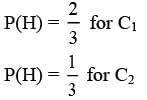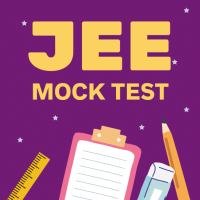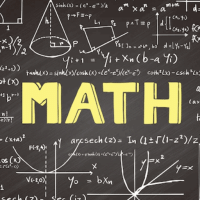JEE Exam > JEE Questions > Let C1 and C2 be two biased coins such that t...
Start Learning for Free
Let C1 and C2 be two biased coins such that the probabilities of getting head in a single toss are 2/3 and 1/3, respectively. Suppose α is the number of heads that appear when C1 is tossed twice, independently, and suppose b is the number of heads that appear when C2 is tossed twice, independently, Then probability that the roots of the quadratic polynomial x2 – αx + β are real and equal, is
- a)40/81
- b)20/81
- c)1/2
- d)1/4
Correct answer is option 'B'. Can you explain this answer?
| FREE This question is part of | Download PDF Attempt this Test |
Verified Answer
Let C1 and C2 be two biased coins such that the probabilities of getti...

For C1

For C2

for real and equal roots
α2 = 4β
(α, β) = (0, 0), (2, 1)
So, probability =

Most Upvoted Answer
Let C1 and C2 be two biased coins such that the probabilities of getti...
We randomly pick one of the coins and toss it twice. Let A be the event that we get two heads, and let B be the event that we get at least one head.
To find P(A), we can use the law of total probability. Let C be the event that we picked coin C1, and let D be the event that we picked coin C2. We want to find P(A), so we can consider two cases:
Case 1: We picked coin C1
P(A|C1) = (2/3)^2 = 4/9
P(C1) = 1/2
Case 2: We picked coin C2
P(A|C2) = (1/3)^2 = 1/9
P(C2) = 1/2
Using the law of total probability, we have:
P(A) = P(A|C1)P(C1) + P(A|C2)P(C2)
= (4/9)(1/2) + (1/9)(1/2)
= 2/9 + 1/18
= 5/18
To find P(B), we can use the complement rule. The complement of event B (not getting at least one head) is getting two tails. Since we have two possible outcomes (coin C1 or C2), we can consider two cases:
Case 1: We picked coin C1
P(two tails|C1) = (1/3)^2 = 1/9
P(C1) = 1/2
Case 2: We picked coin C2
P(two tails|C2) = (2/3)^2 = 4/9
P(C2) = 1/2
Using the law of total probability, we have:
P(B) = 1 - P(two tails)
= 1 - (P(two tails|C1)P(C1) + P(two tails|C2)P(C2))
= 1 - (1/9)(1/2) - (4/9)(1/2)
= 1 - 1/18 - 2/9
= 1 - 1/18 - 4/18
= 1 - 5/18
= 13/18
Therefore, the probability of getting two heads is 5/18, and the probability of getting at least one head is 13/18.
To find P(A), we can use the law of total probability. Let C be the event that we picked coin C1, and let D be the event that we picked coin C2. We want to find P(A), so we can consider two cases:
Case 1: We picked coin C1
P(A|C1) = (2/3)^2 = 4/9
P(C1) = 1/2
Case 2: We picked coin C2
P(A|C2) = (1/3)^2 = 1/9
P(C2) = 1/2
Using the law of total probability, we have:
P(A) = P(A|C1)P(C1) + P(A|C2)P(C2)
= (4/9)(1/2) + (1/9)(1/2)
= 2/9 + 1/18
= 5/18
To find P(B), we can use the complement rule. The complement of event B (not getting at least one head) is getting two tails. Since we have two possible outcomes (coin C1 or C2), we can consider two cases:
Case 1: We picked coin C1
P(two tails|C1) = (1/3)^2 = 1/9
P(C1) = 1/2
Case 2: We picked coin C2
P(two tails|C2) = (2/3)^2 = 4/9
P(C2) = 1/2
Using the law of total probability, we have:
P(B) = 1 - P(two tails)
= 1 - (P(two tails|C1)P(C1) + P(two tails|C2)P(C2))
= 1 - (1/9)(1/2) - (4/9)(1/2)
= 1 - 1/18 - 2/9
= 1 - 1/18 - 4/18
= 1 - 5/18
= 13/18
Therefore, the probability of getting two heads is 5/18, and the probability of getting at least one head is 13/18.
Attention JEE Students!
To make sure you are not studying endlessly, EduRev has designed JEE study material, with Structured Courses, Videos, & Test Series. Plus get personalized analysis, doubt solving and improvement plans to achieve a great score in JEE.

|
Explore Courses for JEE exam
|

|
Let C1 and C2 be two biased coins such that the probabilities of getting head in a single toss are 2/3and 1/3, respectively. Supposeα is the number of heads that appear when C1 is tossed twice,independently, and suppose b is the number of heads that appear when C2 is tossed twice, independently, Then probability that the roots of the quadratic polynomial x2 – αx + β are real and equal, isa)40/81b)20/81c)1/2d)1/4Correct answer is option 'B'. Can you explain this answer?
Question Description
Let C1 and C2 be two biased coins such that the probabilities of getting head in a single toss are 2/3and 1/3, respectively. Supposeα is the number of heads that appear when C1 is tossed twice,independently, and suppose b is the number of heads that appear when C2 is tossed twice, independently, Then probability that the roots of the quadratic polynomial x2 – αx + β are real and equal, isa)40/81b)20/81c)1/2d)1/4Correct answer is option 'B'. Can you explain this answer? for JEE 2024 is part of JEE preparation. The Question and answers have been prepared according to the JEE exam syllabus. Information about Let C1 and C2 be two biased coins such that the probabilities of getting head in a single toss are 2/3and 1/3, respectively. Supposeα is the number of heads that appear when C1 is tossed twice,independently, and suppose b is the number of heads that appear when C2 is tossed twice, independently, Then probability that the roots of the quadratic polynomial x2 – αx + β are real and equal, isa)40/81b)20/81c)1/2d)1/4Correct answer is option 'B'. Can you explain this answer? covers all topics & solutions for JEE 2024 Exam. Find important definitions, questions, meanings, examples, exercises and tests below for Let C1 and C2 be two biased coins such that the probabilities of getting head in a single toss are 2/3and 1/3, respectively. Supposeα is the number of heads that appear when C1 is tossed twice,independently, and suppose b is the number of heads that appear when C2 is tossed twice, independently, Then probability that the roots of the quadratic polynomial x2 – αx + β are real and equal, isa)40/81b)20/81c)1/2d)1/4Correct answer is option 'B'. Can you explain this answer?.
Let C1 and C2 be two biased coins such that the probabilities of getting head in a single toss are 2/3and 1/3, respectively. Supposeα is the number of heads that appear when C1 is tossed twice,independently, and suppose b is the number of heads that appear when C2 is tossed twice, independently, Then probability that the roots of the quadratic polynomial x2 – αx + β are real and equal, isa)40/81b)20/81c)1/2d)1/4Correct answer is option 'B'. Can you explain this answer? for JEE 2024 is part of JEE preparation. The Question and answers have been prepared according to the JEE exam syllabus. Information about Let C1 and C2 be two biased coins such that the probabilities of getting head in a single toss are 2/3and 1/3, respectively. Supposeα is the number of heads that appear when C1 is tossed twice,independently, and suppose b is the number of heads that appear when C2 is tossed twice, independently, Then probability that the roots of the quadratic polynomial x2 – αx + β are real and equal, isa)40/81b)20/81c)1/2d)1/4Correct answer is option 'B'. Can you explain this answer? covers all topics & solutions for JEE 2024 Exam. Find important definitions, questions, meanings, examples, exercises and tests below for Let C1 and C2 be two biased coins such that the probabilities of getting head in a single toss are 2/3and 1/3, respectively. Supposeα is the number of heads that appear when C1 is tossed twice,independently, and suppose b is the number of heads that appear when C2 is tossed twice, independently, Then probability that the roots of the quadratic polynomial x2 – αx + β are real and equal, isa)40/81b)20/81c)1/2d)1/4Correct answer is option 'B'. Can you explain this answer?.
Solutions for Let C1 and C2 be two biased coins such that the probabilities of getting head in a single toss are 2/3and 1/3, respectively. Supposeα is the number of heads that appear when C1 is tossed twice,independently, and suppose b is the number of heads that appear when C2 is tossed twice, independently, Then probability that the roots of the quadratic polynomial x2 – αx + β are real and equal, isa)40/81b)20/81c)1/2d)1/4Correct answer is option 'B'. Can you explain this answer? in English & in Hindi are available as part of our courses for JEE.
Download more important topics, notes, lectures and mock test series for JEE Exam by signing up for free.
Here you can find the meaning of Let C1 and C2 be two biased coins such that the probabilities of getting head in a single toss are 2/3and 1/3, respectively. Supposeα is the number of heads that appear when C1 is tossed twice,independently, and suppose b is the number of heads that appear when C2 is tossed twice, independently, Then probability that the roots of the quadratic polynomial x2 – αx + β are real and equal, isa)40/81b)20/81c)1/2d)1/4Correct answer is option 'B'. Can you explain this answer? defined & explained in the simplest way possible. Besides giving the explanation of
Let C1 and C2 be two biased coins such that the probabilities of getting head in a single toss are 2/3and 1/3, respectively. Supposeα is the number of heads that appear when C1 is tossed twice,independently, and suppose b is the number of heads that appear when C2 is tossed twice, independently, Then probability that the roots of the quadratic polynomial x2 – αx + β are real and equal, isa)40/81b)20/81c)1/2d)1/4Correct answer is option 'B'. Can you explain this answer?, a detailed solution for Let C1 and C2 be two biased coins such that the probabilities of getting head in a single toss are 2/3and 1/3, respectively. Supposeα is the number of heads that appear when C1 is tossed twice,independently, and suppose b is the number of heads that appear when C2 is tossed twice, independently, Then probability that the roots of the quadratic polynomial x2 – αx + β are real and equal, isa)40/81b)20/81c)1/2d)1/4Correct answer is option 'B'. Can you explain this answer? has been provided alongside types of Let C1 and C2 be two biased coins such that the probabilities of getting head in a single toss are 2/3and 1/3, respectively. Supposeα is the number of heads that appear when C1 is tossed twice,independently, and suppose b is the number of heads that appear when C2 is tossed twice, independently, Then probability that the roots of the quadratic polynomial x2 – αx + β are real and equal, isa)40/81b)20/81c)1/2d)1/4Correct answer is option 'B'. Can you explain this answer? theory, EduRev gives you an
ample number of questions to practice Let C1 and C2 be two biased coins such that the probabilities of getting head in a single toss are 2/3and 1/3, respectively. Supposeα is the number of heads that appear when C1 is tossed twice,independently, and suppose b is the number of heads that appear when C2 is tossed twice, independently, Then probability that the roots of the quadratic polynomial x2 – αx + β are real and equal, isa)40/81b)20/81c)1/2d)1/4Correct answer is option 'B'. Can you explain this answer? tests, examples and also practice JEE tests.

|
Explore Courses for JEE exam
|

|
Suggested Free Tests
Signup for Free!
Signup to see your scores go up within 7 days! Learn & Practice with 1000+ FREE Notes, Videos & Tests.






















